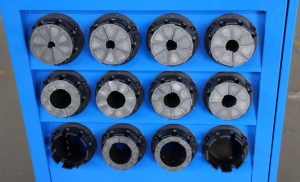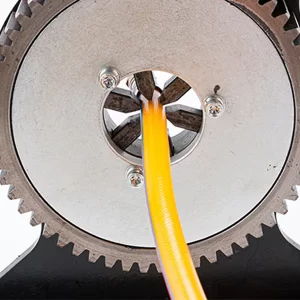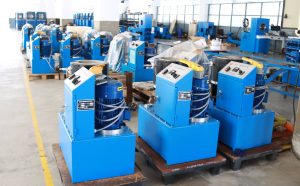Understanding the lifespan of a hydraulic hose crimper is vital for any business relying on hydraulic systems. Hydraulic hose crimpers play a key role in manufacturing and maintenance by ensuring secure, leak-free connections between hoses and fittings. But here’s the kicker: knowing how long these machines last helps companies plan maintenance, control costs, and avoid unexpected downtime. This article covers every detail of hydraulic hose crimper lifecycles, from wear points and maintenance to environmental impacts and replacement decisions. By the end, you’ll have a complete picture of how to maximize your equipment’s efficiency and lifespan.
1. What does the lifecycle of a hydraulic hose crimper include?
The lifecycle of a hydraulic hose crimper refers to the total period during which the machine functions effectively, producing reliable crimps without failure. It starts when the machine is first put into service and ends when it no longer meets performance or safety standards. This is where it gets interesting: the lifecycle isn’t just about years; it’s also influenced by usage intensity, maintenance, and environment. For example, a machine in a high-volume factory may last less time than one used sporadically in a small shop.
Lifecycle stages typically include initial calibration, peak performance, gradual wear and tear, maintenance interventions, and eventual decline. Some companies track lifecycle in terms of crimp cycles — the number of crimps performed — because this metric reflects real workload more accurately than calendar years.
Three examples illustrate lifecycle variations: a construction equipment manufacturer using a high-volume automatic crimper sees a lifecycle of about 5 years; a small hydraulic repair shop with manual machines reports 8-10 years; and an aerospace maintenance facility with highly specialized machines tracks cycles closely, extending lifecycle with preventive maintenance.
Lifecycle understanding helps businesses plan procurement, budget for replacements, and minimize downtime by scheduling maintenance during slower periods.
| Lifecycle Stage | Description | Typical Duration |
|---|---|---|
| Initial Calibration | Machine setup and first uses | 1-3 months |
| Peak Performance | Optimal function and output | 2-5 years |
| Wear and Tear | Signs of degradation appear | 3-7 years |
| Maintenance Phase | Frequent repairs and upkeep | 1-3 years |
| Decline and Replacement | Machine no longer reliable | After 5-10 years |
2. How long do hydraulic hose crimpers usually last?
Hydraulic hose crimper lifespan varies widely depending on factors like usage frequency, maintenance rigor, machine quality, and working conditions. Ready for the good part? Manual machines often last longer than electric or automatic ones due to simpler mechanics but may not handle high-volume tasks efficiently.
On average, manual machines have a lifespan of 8-12 years when properly maintained. Electric crimpers typically last 5-8 years, while automatic crimpers, due to complex electronics and moving parts, range between 3-7 years.
Case studies support this: a mid-sized manufacturing plant found their manual crimper lasted 10 years with weekly use; a large facility running electric crimpers daily reported a 6-year lifespan; and an industrial rental company using automatic crimpers noticed replacement every 4 years due to intensive cycles.
Understanding lifespan helps with budgeting and choosing the right type for your operation. Frequent maintenance can extend these figures significantly, while poor care shortens useful life.
| Machine Type | Average Lifespan | Usage Context |
|---|---|---|
| Manual | 8-12 years | Low to medium volume use |
| Electric | 5-8 years | Medium volume with regular use |
| Automatic | 3-7 years | High volume and intensive use |
3. What are the main wear points in a hydraulic hose crimper?
Several critical components face regular wear and are common failure points in hydraulic hose crimpers. But here’s the kicker: addressing these wear points through preventive maintenance is key to extending machine life.
Crimping dies and press heads experience the highest mechanical stress. Constant compression causes surface wear and deformation over time. Hydraulic pumps and internal seals are susceptible to leaks and pressure loss, impacting crimp consistency. Electronic components, including sensors and control boards, may fail due to heat, dust, or electrical issues.
In one case, a factory reported that replacing crimping dies every 18 months maintained crimp quality and avoided downtime. Another company experienced hydraulic seal failure after 3 years but extended machine life by upgrading seals and hydraulic fluid quality. A third user found that regular cleaning and protective covers prevented early electronic failure in dusty environments.
Understanding these wear points helps prioritize inspections and part replacements, saving costs and downtime.
| Wear Point | Common Issues | Maintenance Tips |
|---|---|---|
| Crimping Dies | Wear, deformation | Regular replacement, inspection |
| Hydraulic Pump & Seals | Leakage, pressure loss | Seal replacement, fluid checks |
| Electronics & Sensors | Malfunctions, corrosion | Cleaning, protective housing |
4. What signs indicate a crimper is nearing end-of-life?
Identifying when a hydraulic hose crimper is approaching the end of its lifecycle helps avoid sudden breakdowns. This is where it gets interesting: some signs are subtle while others are obvious.
Inconsistent crimping pressure or varying crimp sizes often point to hydraulic leaks, worn dies, or calibration issues. Unusual noises or vibrations may indicate mechanical wear or failing bearings. Oil leaks around seals show hydraulic system problems. Frequent recalibration needs and software glitches are red flags for electronic component aging.
For example, an automotive parts supplier noticed increasing crimp failures and machine vibration after 5 years, prompting replacement. A hydraulic service center found frequent oil leaks and poor crimp results at 6 years, extending machine life only through expensive repairs. A rental business replaced machines after sensor failures led to safety concerns.
Regular inspections and logging issues help detect these signs early, allowing timely maintenance or replacement.
| Sign | Possible Cause | Recommended Action |
|---|---|---|
| Inconsistent Crimp | Hydraulic leaks, worn dies | Inspect and replace parts |
| Noises/Vibrations | Mechanical wear | Maintenance or replacement |
| Oil Leakage | Seal failure | Seal replacement |
| Frequent Recalibration | Electronics aging | System diagnostics, upgrades |
5. How can regular maintenance extend a crimper’s life?
Maintenance directly influences the lifespan of hydraulic hose crimpers. Ready for the good part? Machines maintained properly often outlive their expected service life.
Daily tasks include cleaning debris, inspecting hoses and seals, and checking hydraulic fluid levels. Weekly maintenance focuses on lubricating moving parts, tightening fittings, and testing pressure. Monthly checks involve detailed inspection of dies, hydraulic pumps, and electronic calibration.
In one factory, routine maintenance reduced unplanned downtime by 40%. A rental company implemented scheduled lubrication and seal replacement, extending machine life by 2 years. Another business trained operators to perform daily checks, avoiding major repairs.
Ignoring maintenance leads to accelerated wear, inconsistent crimps, and higher repair costs, cutting machine life short.
| Maintenance Frequency | Tasks | Benefits |
|---|---|---|
| Daily | Cleaning, fluid level checks | Prevents dirt damage |
| Weekly | Lubrication, fitting checks | Ensures smooth operation |
| Monthly | Detailed inspections | Detects wear early |
6. What role does operator training play in equipment lifespan?
Operator skill impacts the durability of hydraulic hose crimpers more than many realize. But here’s the kicker: misuse or improper technique often causes premature wear or damage.
Proper loading of hoses and fittings avoids misalignment, which can damage dies or cause faulty crimps. Understanding machine limits prevents over-crimping, protecting hydraulic pumps and dies. Trained operators spot issues early and perform basic maintenance correctly.
A manufacturing plant reported that after operator training, machine failures dropped 30% annually. A hydraulic service firm found inexperienced users caused 50% more die damage. Another company credited formal certification programs for improved machine reliability.
Training isn’t just about efficiency; it’s critical to extending equipment life.
| Training Aspect | Impact on Machine | Result |
|---|---|---|
| Proper Loading | Prevents misalignment | Reduces die wear |
| Correct Pressure Use | Avoids over-crimping | Protects hydraulic components |
| Basic Maintenance | Early issue detection | Fewer breakdowns |
7. Are there usage benchmarks or cycle counts to track lifespan?
Tracking hydraulic hose crimper usage via cycles or benchmarks helps optimize lifecycle management. What’s the real story? Many machines come with built-in cycle counters to monitor usage.
Manufacturers often recommend replacement after a certain number of crimps or operating hours. For instance, a popular automatic crimper might be rated for 500,000 cycles. Tracking actual usage helps schedule maintenance before failures occur.
An aerospace company uses cycle tracking combined with machine logs to predict service needs, preventing downtime. A hydraulic shop uses cycle data to plan parts replacement, extending machine life cost-effectively. Others rely on operating hours and workload type to adjust maintenance schedules.
Integrating data-driven lifecycle tracking is increasingly common and effective.
| Tracking Method | Description | Benefit |
|---|---|---|
| Cycle Counters | Records crimp counts | Timely maintenance scheduling |
| Operating Hours | Tracks active machine time | Assesses wear and usage |
| Usage Logs | Manual or digital records | Informs lifecycle planning |
8. How do environmental conditions affect lifecycle?
Environment plays a significant role in the durability of hydraulic hose crimpers. Dust, humidity, temperature extremes, and storage conditions accelerate wear. This is where it gets interesting: poor environments lead to faster deterioration of mechanical and electronic components.
For example, machines operating in dusty construction sites often require more frequent cleaning and parts replacement. High humidity can corrode metal parts and damage electronics. Machines stored outdoors or without protective covers experience accelerated wear.
An oilfield operator replaced crimpers every 3 years due to harsh conditions, while a factory using controlled indoor environments extended lifespan beyond 8 years. Preventive measures include sealed enclosures, controlled humidity, and regular cleaning.
| Environmental Factor | Effect on Machine | Mitigation |
|---|---|---|
| Dust | Abrasion, clogging | Regular cleaning, filters |
| Humidity | Corrosion, electronics damage | Protective coatings, ventilation |
| Temperature Extremes | Material fatigue | Climate-controlled storage |
9. What’s the difference in lifespan between manual and automatic crimpers?
Manual and automatic hydraulic hose crimpers differ significantly in complexity, usage, and lifespan. But here’s the kicker: simpler manual machines often outlast more complex automatic ones.
Manual crimpers have fewer moving parts, which means less mechanical failure risk. They last 8-12 years with proper care but are slower and less consistent. Automatic machines offer speed and precision but have electronic components prone to failure, typically lasting 3-7 years.
For example, a hydraulic repair shop uses manual crimpers for small jobs and reports decade-long machine life. A high-volume manufacturer relies on automatic crimpers replaced every 4 years. The choice depends on workload and budget.
| Machine Type | Complexity | Average Lifespan | Best Use Case |
|---|---|---|---|
| Manual | Low | 8-12 years | Low volume, budget focus |
| Automatic | High | 3-7 years | High volume, precision |
10. Can parts replacement reset or extend a crimper’s lifecycle?
Replacing worn or damaged parts can significantly extend a hydraulic hose crimper’s usable life. Ready for the good part? Common replaceable parts include crimping dies, hydraulic seals, hoses, and electronic sensors.
For instance, replacing crimping dies regularly ensures crimp quality and avoids damage to hoses. Hydraulic seals and hoses can wear out causing leaks but are often inexpensive to replace. Electronic components may require occasional upgrades or repairs.
One facility extended machine life by 30% through scheduled parts replacement. Another balanced repair costs with machine age to decide on replacement timing. Warranty coverage often includes parts replacement, reducing costs.
| Part | Replacement Frequency | Cost Impact | Lifecycle Effect |
|---|---|---|---|
| Crimping Dies | 12-18 months | Moderate | Maintains crimp quality |
| Hydraulic Seals | 1-3 years | Low | Prevents leaks |
| Electronics | 3-5 years | High | Ensures control accuracy |
11. When is it more economical to replace rather than repair?
Deciding between repairing and replacing a hydraulic hose crimper depends on factors like repair costs, machine age, and downtime. What’s the real story? If repair costs exceed 50% of new machine price or downtime causes significant loss, replacement is often wiser.
Frequent breakdowns, inability to source parts, and outdated technology also tip the scale towards replacement. A rental company replaced crimpers after 3 costly repairs in one year. A manufacturer with older machines upgraded to improve efficiency and reduce maintenance.
Cost of ownership calculations that include purchase, maintenance, and downtime help guide decisions.
| Factor | Repair Viability | Replacement Advantage |
|---|---|---|
| Repair Cost | Low to moderate | High repair cost |
| Machine Age | Newer machines | Older or obsolete |
| Downtime Impact | Minimal | High operational cost |
12. How do brands compare in terms of durability?
Different manufacturers produce hydraulic hose crimpers with varying durability and support. But here’s the kicker: brand reputation often reflects build quality, parts availability, and customer service.
Top brands like Parker, Eaton, and Gates are known for durable machines with solid warranties. Lesser-known brands may offer lower prices but have shorter lifecycles and limited support. Reviews indicate that premium brands often save costs long term due to reliability.
One industrial buyer found that investing in a premium brand reduced downtime by 25%. Another switched brands after frequent failures with cheaper machines.
| Brand | Durability Rating | Warranty Period | Support Quality |
|---|---|---|---|
| Parker | High | 3-5 years | Excellent |
| Eaton | High | 3-4 years | Very good |
| Gates | Moderate | 2-3 years | Good |
| Generic Brands | Low | 1-2 years | Limited |
13. What are best practices for documenting a crimper’s condition?
Keeping detailed records of machine condition helps track lifecycle and plan maintenance. This is where it gets interesting: documentation supports warranty claims and improves operational planning.
Maintenance logs should include dates, performed tasks, replaced parts, and observed issues. Inspection reports help spot trends in wear or performance decline. Digital tools and apps facilitate real-time data entry and alerts.
A hydraulic shop uses tablets for logging, improving accuracy and communication. Another business relies on paper logs but is transitioning to digital. Regular documentation empowers proactive lifecycle management.
| Documentation Type | Purpose | Tools Used |
|---|---|---|
| Maintenance Logs | Track service and repairs | Paper, digital apps |
| Inspection Reports | Record condition | Checklists, photos |
| Usage Records | Monitor cycles/hours | Machine counters, software |
14. How do warranty terms impact lifecycle decisions?
Warranty coverage affects how businesses approach machine use and lifecycle management. Ready for the good part? Knowing warranty terms helps decide when to repair versus replace.
Typical warranties cover parts and labor for 1-5 years, depending on brand and model. Extended warranties or service contracts may add coverage but increase upfront costs. Some warranties require strict adherence to maintenance schedules.
An aerospace company carefully tracked warranty expirations to plan replacements, avoiding costly out-of-warranty repairs. Others lost coverage by skipping scheduled service.
Understanding warranty terms minimizes risk and guides lifecycle investment.
| Warranty Aspect | Typical Coverage | Impact on Decisions |
|---|---|---|
| Duration | 1-5 years | Replacement timing |
| Service Requirements | Scheduled maintenance | Keeps warranty valid |
| Coverage Limits | Parts and labor | Repair vs. replacement |
15. What can you do to maximize ROI over the machine’s lifetime?
Maximizing ROI on hydraulic hose crimpers requires balancing purchase price, maintenance costs, and productivity gains. But here’s the kicker: effective use, training, and maintenance are as important as initial investment.
Calculating cost per crimp or per cycle helps track true ROI. Efficient scheduling reduces downtime and extends machine life. Training operators to avoid damage and perform routine maintenance lowers repair expenses.
A company improved ROI by 20% through operator training and preventive maintenance. Another optimized workflows to increase machine utilization without overloading.
Maximizing ROI ensures hydraulic hose crimpers remain valuable assets throughout their lifecycle.
| ROI Factor | Strategy | Result |
|---|---|---|
| Purchase Price | Invest wisely | Long-term savings |
| Maintenance | Preventive care | Reduced repair costs |
| Operator Training | Skill development | Increased uptime |
FAQ Section
Q1: What is the lifecycle of a hydraulic hose crimper?
It’s the total functional period during which the crimper reliably performs, typically measured in years or crimping cycles, depending on usage and maintenance.
Q2: How does regular maintenance affect machine lifespan?
Proper upkeep prevents wear and mechanical failure, often extending the useful life by several years beyond expected averages.
Q3: How can I tell if my crimper needs replacement?
If the machine shows inconsistent results, frequent breakdowns, or requires costly repairs, it might be time to consider a replacement.
Q4: Is it better to repair or replace parts of a crimper?
Replacing worn parts is cost-effective early on, but extensive repairs later in the lifecycle may exceed the value of buying a new unit.
Q5: Does the working environment impact crimper durability?
Absolutely. Dust, moisture, and temperature extremes can accelerate wear and reduce the overall life expectancy of the machine.




